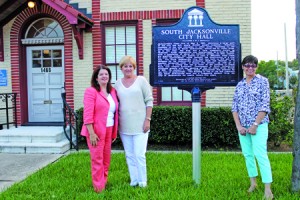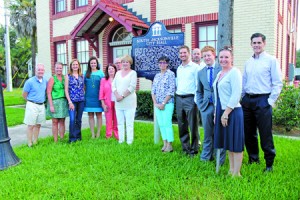New Historic markers installed in San Marco
Posted on September 3, 2013 By Editor Articles, Neighborhood News, Top Stories
Gives residents a sense of community

District 14 Councilwoman Lori Boyer, with former San Marco Preservation Society board members Robin Robinson and Jennifer Newman at newly installed historic marker
Thanks to the efforts of Jennifer Newman, there are four new historic markers in San Marco. The markers are located at the San Marco Preservation Society building on Hendricks, Oriental Gardens Road at San Jose Boulevard, Davin Park on River Road and the newly renovated Balis Park on the Square.
Newman spearheaded the efforts to get the historic markers approved by the State of Florida, created and then installed by City of Jacksonville Public Works Department. She was also instrumental in the preservation and renovation of the South Jacksonville City Hall building from the application for a state grant in 2004 to the grand opening in January 2008 along with Rob Smith and Keith Kimball.

Left to right: George Foote, Heather Stine, Diane Martin, Liz Morgan, Lori Boyer, Jay Robinson, Robin Robinson, Jennifer Newman, Reese Riggle, Andrew Dickson, Anthony Edwards, Desiree Bailey, Doug Skiles
“I drove past this building for years and never knew what it was or what it stood for,” said San Marco Preservation Society former board member Robin Robinson. “In 2004, Matt Carlucci [Jacksonville Historical Society Board] came to San Marco Preservation and said the building could be available, and it was about that time we realized it was the South Jacksonville City Hall.”
Newman shared that the former City Hall was in a very serious state of disrepair when she was board president in 2001-2002. “The firemen’s union had been in here for a number of years and it was deteriorating, the walls were falling in, plaster falling off and the windows were beyond repair.” She wrote a grant to the state historic preservation commission requesting an initial $300,000. “If it hadn’t been for Lori Boyer and her political skills, going over and helping us lobby for the grant, we would never have gotten the money,” said Newman.
Robinson continued, “We really stuck our necks out doing this.
We operate pretty close to our budget and didn’t have extra money to pay utilities and everything that goes into operating a building. We took a big chance.” A portion of the operating expenses is paid by Greenscape, a tenant on the top floor.
The other three markers were chosen based on what residents thought were most historically interesting to people, according to Newman. “These markers that are all around town provide immensely fascinating stories about San Marco history,” said Reese Riggle, board president. “Having those stories forever on these markers give people a sense of community.”
By Kate A. Hallock
Resident Community News
Four sites selected
Villa Alexandria
Villa Alexandria, built in the 1870s as the winter home of Alexander and Martha Mitchell of Milwaukee, WI, once stood near what is now Davin Park on River Road. Martha Mitchell became enthralled with this setting and purchased 140 acres that became known as Villa Alexandria.
During the late 19th century, Villa Alexandria was “the showplace of the environs of Jacksonville.” The grounds featured carriageways, extensive vegetation, a boathouse, orange groves, a swimming pool, fountains, pools and artificial streams.
Villa Alexandria was demolished around 1925 to make way for the San Marco subdivision.
Oriental Gardens
Located on San Jose Boulevard, south of Craig Creek in San Marco, Oriental Gardens charmed Jacksonville visitors and residents for nearly two decades. In 1925, George W. Clark began planting overflow from his botanical collection on a bluff that he owned overlooking the St. Johns River. This 18-acre private estate was opened to the public in October 1937 and, until 1954, was Jacksonville’s major tourist attraction.
In 1954, the estate was purchased by the State Investment Company and subdivided into 33 single family home sites. Even though the gardens are gone, their remnants, such as statuary, gate posts, and the original stairs to the river, can be seen along Oriental Gardens Road which is now dominated by mid and late 20th century single family homes.
South Jacksonville City Hall
Jacksonville’s Great Fire of May 3, 1901 destroyed a large part of the city and left nearly 10,000 people homeless. Numerous residents of the city relocated to other areas, including to the then remote area of South Jacksonville, across the St. John’s River.
The South Jacksonville City Hall was built on Hendricks Avenue in 1915 in a masonry vernacular style, and housed city offices, as well as a fire truck. A trolley line ran in front of the building to Beach Road, now Atlantic Boulevard.
Development in South Jacksonville expanded greatly with the opening of the St. Johns River Bridge in 1921. On January 1, 1932, South Jacksonville was annexed by the City of Jacksonville. This building is one of the few reminders that South Jacksonville once was a community distinct from the City of Jacksonville for nearly 25 years.
San Marco Square
With the opening of the St. John’s River Bridge in 1921, South Jacksonville became attractive to developers during the Florida land boom. In 1925, Jacksonville real estate developer Telfair Stockton began work on San Marco, an 80-acre Mediterranean-inspired community.
Unlike many earlier developments, which were laid out following a grid street pattern, San Marco shows the influence of the City Beautiful movement. Its winding streets, planted medians, and use of parks and larger lots create a varied landscape and interesting building sites.
By late 1926 the development’s business district, San Marco Square, was laid out. It was inspired by the Piazza San Marco in Venice, which Stockton had visited on a trip to Europe. One of the Square’s original buildings, the St. Mark’s Building, built in 1927, retains an arched façade and tile roof typical of the Mediterranean Revival style of architecture.




 (1 votes, average: 4.00 out of 5)
(1 votes, average: 4.00 out of 5)




